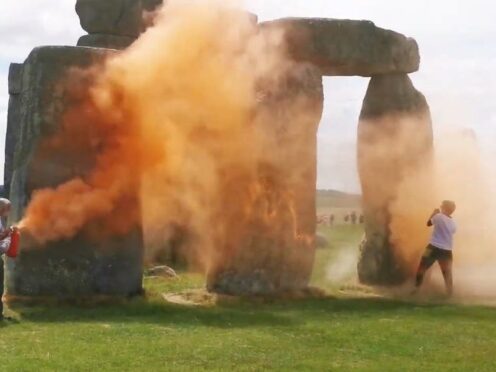
Two Just Stop Oil activists who were arrested after Stonehenge was sprayed with orange paint have been released on bail.
Wiltshire Police said a man in his 70s and a woman in her 20s had been bailed after being arrested on suspicion of criminal damage, damaging an ancient monument and deterring a person from engaging in a lawful activity.
Video footage posted on social media on Wednesday appeared to show two people wearing white shirts with the slogan Just Stop Oil approaching the stone circle with canisters and spraying orange powder paint.
Members of the public struggled with the campaigners – named by the group as Rajan Naidu, 73, and Niamh Lynch, 21 – as they appeared to run up to Stonehenge.
Dr Nick Merriman, chief executive of English Heritage, said on Thursday that the paint had been removed and there appeared to be “no visible damage” to the monument.
And English Heritage, which manages Stonehenge, said removing the orange powder could still have a “harmful impact” though by “eroding the already fragile stone and damaging the lichens”.
Dr Merriman told BBC Radio 4’s Today Programme: “It’s difficult to understand and we’re deeply saddened about this vandalism, but we’ve been really touched by the messages of sympathy and support we’ve had.
“Our experts have already managed to clean the orange powder from the stones because we were really worried about what would happen if they got in contact with water.
“So far, there seems to be no visible damage. The site is open to the public again and for the solstice tomorrow.”
The orange cornflour we used will soon wash away with the rain, but the urgent need for effective government action to mitigate the catastrophic consequences of the climate and ecological crisis will not.
— Just Stop Oil (@JustStop_Oil) June 19, 2024
Discussing the action by Just Stop Oil, Dr Merriman said: “It’s vandalism to one of the world’s most celebrated ancient monuments.
“We wish people would channel their protests away from cultural heritage sites, museums and galleries because we feel that doesn’t actually help their cause, and causes huge upset and disruption to the operation of these important sites.”
Rishi Sunak and Sir Keir Starmer were united in condemnation of Just Stop Oil after the incident.
The Prime Minister described it as a “disgraceful act of vandalism” while the Labour leader branded the group “pathetic”.
In a statement on the two people who were bailed, Wiltshire Police said: “This is to allow us additional time to work with specialists and progress our inquiries.
“A man in his 70s and a woman in her 20s were arrested on suspicion of criminal damage, damaging an ancient monument and deterring a person from engaging in a lawful activity.
“It follows reports that an orange substance had been sprayed on some of the stones by two suspects.
“We also continue to work closely with English Heritage.”
English Heritage said in a statement: “We can’t understand why anyone who professes to care for the environment would attempt to harm such a monument and to distress people from all over the world, including those for whom Stonehenge holds a spiritual significance.”
The charity added: “We moved quickly due to the risk that the powder would harm the important and rare lichens growing on the stones and that if the powder came into contact with water, it would leave difficult-to-remove streaks.
“And while we are relieved that there appears to be no visible damage, the very act of removing the powder can – in itself – have a harmful impact by eroding the already fragile stone and damaging the lichens.”

Enjoy the convenience of having The Sunday Post delivered as a digital ePaper straight to your smartphone, tablet or computer.
Subscribe for only £5.49 a month and enjoy all the benefits of the printed paper as a digital replica.
Subscribe